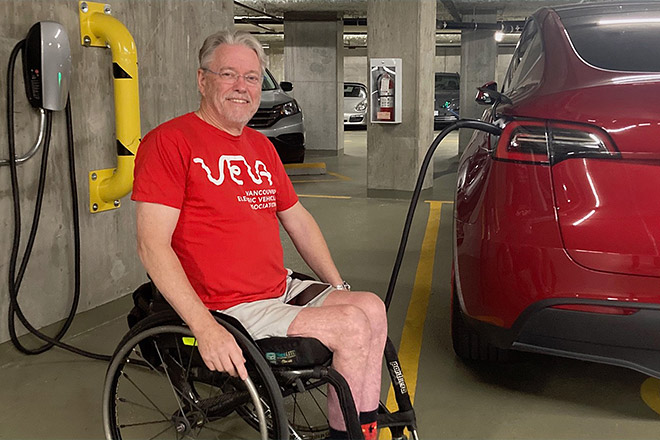Tesla and a wheelchair: the drive for accessibility

EV driver helps remove barriers at charging stations
Passing out from heat exhaustion while on a motorcycle put Jacques Courteau in a coma, then a wheelchair, and eventually in a Tesla Model 3 equipped with hand controls.
Travelling 24,000-kilometres cross and around North America in that Tesla made him arguably B.C.'s leading advocate for charging station accessibility.
"Sometimes, you can't even get to a charger, and that's the worst," says Courteau, no fan of curbs or other barriers that block access to a charger. "And once you actually use a charger, the weight of the cable makes it tough for me to drag it from the charger to my car and back."
Chair of the City of Vancouver's Accessibility Strategy Task Force, Courteau helps advocate for improvements to make city infrastructure, facilities, programs, and services accessible and inclusive for all. And it was at a meeting hosted by the Vancouver Electric Vehicle Association, that Courteau told BC Hydro that he was unable to use the majority of B.C. fast charging stations because of the way they were configured.
Two members of the our EV team followed up by visiting four different BC Hydro charging stations with Courteau, and were quickly convinced that station design had to change.
"We saw firsthand all the barriers that made these sites difficult for him to use," says EV program manager Chris Trigardi, recalling the site visits. "That's when we sat down with our team and discussed more accessible designs to ensure everyone has the ability to use our sites moving forward."
Late last summer, we announced that our new stations would be accessible, and that we would move to retrofit existing stations for accessibility within three years. Our new standard is to design stations that include:
- Level, paved ground access to chargers. Surface is firm and slip resistant with concrete or asphalt.
- Wider parking spaces with painted hash marks between charging spots; to allow for a car door to be fully opened
- Posts that protect charging equipment but that don't interfere with wheelchair access
- Lighter weight charging cables and cable management systems designed to help all users
- Purchasing hardware that meets US ADA requirements of a lower screen, holster and cables at a more accessible height
"I was amazed at how fast there was pick-up from BC Hydro on this issue," says Courteau. "I spoke to them and within two weeks, we had our first phone call. And everything else after that has been amazing."
There are now more than 120,000 EVs on the road in B.C., and we predict there will be between 700,000 and 900,000 EVs within the next 10 years. Our province-wide fast charging network currently includes 153 charging units at 84 sites in communities throughout the province. And we're looking to add 3,000 ports to our network over the next 10 years.
The chargers are funded in a partnership with the Province of B.C. and Natural Resources Canada.
For now, it's trial and error for EV drivers with mobility challenges
As a Tesla driver, Courteau uses a mix of Tesla superchargers, a Tesla Level 2 charger in his condo parking spot, and public chargers. And accessibility at these charging stations varies dramatically.
He recalls once plugging into a Tesla supercharger and, upon returning to his car, discovering that another driver had parked so close to his Model 3 that he couldn't get to the cable to unplug it from his car. He was forced to wait more than 20 minutes until another driver appeared and was able to unplug the charger.
"Accessibility depends on which disability you have," says Courteau, a remarkably fit 70-year-old, agile and strong, thanks in part to his regimen of tennis and other sports. "You just have to go out there, try the charging stations closest to your home, and get used to the one that works best for you. I can go to a station where the charger is mounted on pavement, where the space is just right... but if the cable is all over the ground because there's no cable management system, I won't be able to pick it up and put it away."
In addition to his work as a volunteer with the City of Vancouver, Courteau is on a Vancouver Electric Vehicle Association committee that frequently makes presentations to governments around accessibility. And closer to home, he has taken up the cause as chair of his apartment complex's strata council.
The first charger in Courteau's Yaletown apartment building was in the underground visitor parking area. This required him to go outside the building and wheel his way through the parking entrance to get to the spot. He urged the strata council to allow him to add his own charger, and after lobbying other apartment owners, was overjoyed that a motion to add charging infrastructure to everyone's parking spots passed by a wide margin.
"It's a 362-unit building, and with provincial subsidies, we're able to install one charger for each unit," he says. "The vote was 97% in favour. And although there are only a few electric car owners in the building now, 138 owners opted to get chargers installed."
Related:
- EV charging in B.C., at home and on the go (BC Hydro)
- BC Hydro to add higher-powered chargers to network
- EV incentives in B.C. (BC Hydro)
- Public charging in B.C. (BC Hydro)
- Accessibility (BC Hydro)
- City of Vancouver Accessibility Task Force